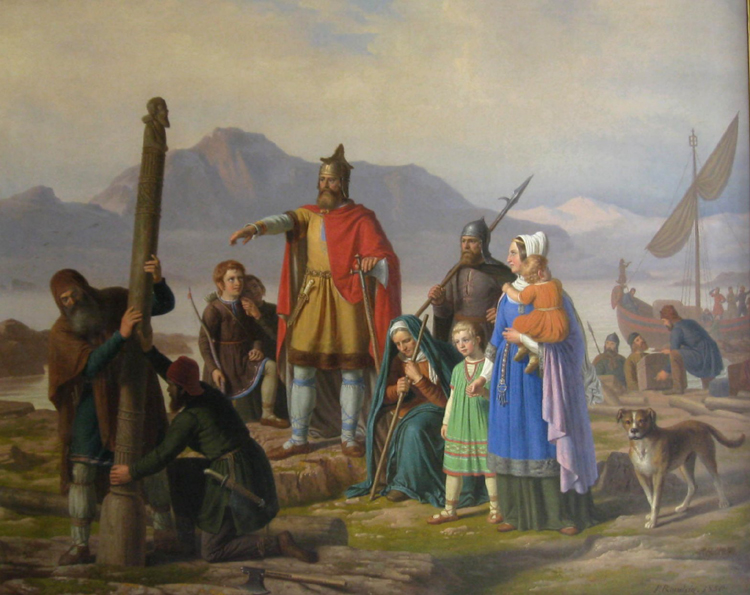
The Icelandic Commonwealth
The story goes that Iceland was discovered by a series of viking adventurers: in 850 by the Norwegian Naddoddr and in the 860s by the Swede Garđar
Svavarsson and the Norwegians Flóki Vilgerđason (who supposedly set out looking for it with the aid of three ravens and followed the one that did not
return, and thus is known as Hrafna-Flóki), both of whom overwintered but did not stay. It was at that time covered in birch forest and only a few Irish
hermits lived there. Flóki was shocked by the cold winter but one of his companions, summing up how fertile the land seemed to him, said every blade of
grass seemed to drip with butter. It was called "Iceland" either because Flóki saw a bay full of icebergs or perhaps more likely in an attempt to discourage
everybody from coming over.
The Icelandic Landnámabók ("Book of Settlements") is the official account of how the new country was settled, based on family histories. It states that
the first settler was Ingólfr Arnarson, in the Reykjavík area, between 870 and 874.
He was from Norway and so were virtually all the initial settlers. They were overwhelmingly aristocrats who objected to the consolidation of power (and
consequent taxation) by Harald Fairhair; by his death in 930, almost all the good land had been settled. There was also a religious dimension to their
decision. Many of the settlers were obviously very close to Thor. 984 of the roughly 4,000 names in Landnámabók are Thor-names (DeVries 2.120). Ţórolf
Mostrarskegg brought the pillars from his Thor temple, on which an image of the Thunderer was carved, and when he came in sight of land threw them
overboard; where "Thor landed," as he put it, he settled and built him a fine new temple. In the following generations, Icelanders were named for Thor in
even greater numbers and continued to call on him in the majority of stories about heathens in the Icelandic sagas. In contrast the court poetry of the
Norwegian kings and the Hlađir jarls focussed on Óđinn and Valhalla, and Jarl Hákon Sigurdsson is described blóting primarily the mysterious valkyrie-like
Thorgerđr Hölgabrúđr and Irpa. Some have suggested Hárbarđsljóđ is a Norwegian poem; certainly it illustrates that there were tensions within late
Scandinavian heathenry between those who saw aristocracy embodied in Óđinn and Thor as "common" and those who identified with him. There are also a large
number of Thor names among the Norse settlers in Ireland.
The Irish hermits left because they did not want to be around heathens - likely with some encouragement, as the settlers all vigorously claimed their land,
sometimes squabbling over it. They were all from noble families and many had been chieftains in Norway. Thus they divided the country into 39 chieftainships
(gođorđ) each under the jurisdiction of a gođi. The word means a heathen priest, but from very early on in Iceland more attention was paid to the function as
chieftain and local judge, deciding cases at the regional things held every spring, and after the conversion the gođar retained their offices. A gođorđ was
inherited, not appointed, although theoretically a non-chief chose which gođi he owed allegiance to. In 930 the Althing (Alţingi) was established as a national
parliament. All free men could attend the Althing (ancestor of the current Icelandic parliament which still bears the name), and the law of the land was made
by the Lögrétta, its legislative section, which consisted of the gođar, the Lawspeaker (Lögsögumađr - its highest office), and nine additional members. The
country was thus an aristocratic republic. The Althing met every summer at Ţingvellir, a plain with a wall of volcanic rock running through it that amplified
voices. The primary job of the Lawspeaker was to stand on the Law Rock (Lögberg) and recite the laws. Originally the Althing also decided legal cases, but
around 965 the country was subdivided into four quarters and a court of appeals of 36 judges established at the Althing. Early in the 11th century a fifth
court was added for recourse beyond them, with judges appointed by the Lögrétta.
The settler families brought in a large number of Irish and Scottish thralls, concubines, and in some cases wives.
With clearing of land for farming, burning of wood for heating and for smelting metal, and grazing by sheep and pigs, the land became rapidly deforested
and most of the topsoil was lost to erosion. Today the central portion is an Arctic desert and although many trees have been planted in the last 30 years,
until this generation they were a rare sight. Notice how few trees there are in these photographs of
abandoned Icelandic farms (link will open a new window).
The Icelanders relied heavily on fishing to supplement the animals they raised, and when a whale beached on the coast it was a great windfall and everyone
participated in cutting the meat off it so it could be used. Trading was also very important to the economy, both as a cultural tradition and because of the
limited resources of the island.

Artwork by Johan Peter Raadsig, photographed by Haukurth, Wikimedia Commons
Johan Peter Raadsig painting from 1850 depicting Ingolf having his highseat pillars set up to claim Reykjavík.
[1. Johan Peter Raadsig Ingolf image from http://en.wikipedia.org/wiki/File:Ingolf_by_Raadsig.jpg]
|
